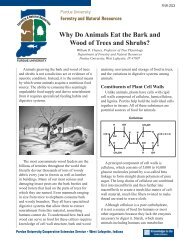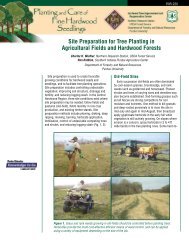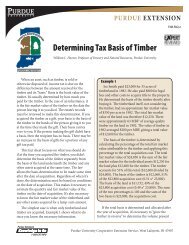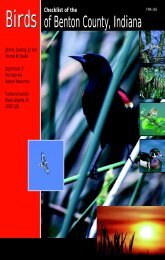Organic Vegetable Production - Purdue Extension - Purdue University
Organic Vegetable Production - Purdue Extension - Purdue University
Organic Vegetable Production - Purdue Extension - Purdue University
Create successful ePaper yourself
Turn your PDF publications into a flip-book with our unique Google optimized e-Paper software.
were released they would leave the area. Purchase of biocontrol<br />
agents does however, make good sense in greenhouse<br />
situations where the beneficial insects can be contained.<br />
Since many adult predators and parasitoids feed on<br />
nectar and pollen, it is essential to have these resources<br />
nearby. A variety of plants will be more effective than a<br />
single species. An example would be several types of clover<br />
(red, crimson, sweet, white, etc.) along with more traditional<br />
flowers like marigolds, zinnias, etc. The objective is to have<br />
a continuous nectar and pollen source throughout the season.<br />
The closer these flowering plants are to the vegetables the<br />
more often the vegetable plants will be searched by the<br />
parasitoids or predators. In addition to natural enemies,<br />
flowering plants will attract a wide variety of pollinators<br />
such as honeybees, bumble bees, wasps, and butterflies.<br />
Creating a diverse environment of flowers and vegetables<br />
favors parasitoids, predators, and insect diseases over pests.<br />
<strong>Organic</strong> mulch, such as straw and grass clippings not only<br />
acts as a weed barrier, but as it decays, the mulch becomes<br />
a haven for soil predators such as carabid and staphylinid<br />
beetles, spiders, and centipedes. Therefore, mulching should<br />
be encouraged in the field whenever possible, but not too<br />
early in the year when the soil is cold and damp. This could<br />
lead to additional pest problems. Wait until the soil warms to<br />
approximately 70°F at a 4 inch depth before mulching. With<br />
nectar/pollen sources and mulch available throughout the<br />
growing season, natural enemies should be present in<br />
numbers sufficient to handle most potential pest problems.<br />
Another biocontrol is insect diseases (or microbial<br />
controls). There are fungi, viruses, bacteria, and nematodes<br />
that attack insects and help keep their populations under<br />
control. Moist conditions are usually necessary for most of<br />
these to work, especially fungal pathogens. Insect populations<br />
often need to be at fairly high numbers (numbers too<br />
high to be tolerated in the field) before the diseases spread<br />
efficiently. There are a few commercial products that contain<br />
these microbial organisms. These products will be discussed<br />
in the “organic insecticides” section. In very dry years, the<br />
pathogens will not work as well as they should and there could<br />
be an explosion of some pests like grasshoppers or hornworms.<br />
Companion Planting (Intercropping) - In natural<br />
systems (especially old field) there is always a variety of<br />
plant species. However, in the vegetable garden we abandon<br />
this companion planting scheme and make our vegetables<br />
mini-monocultures. There has been much said and written<br />
about the insect repellent properties of certain plant combinations,<br />
but there is little experimental evidence demon-<br />
8<br />
strating their efficiency. For example, marigolds are supposed<br />
to have many insect repellent properties, but in our<br />
studies, we found no difference in the number of pests on<br />
cabbage or tomatoes when marigolds were present vs. when<br />
they were not. The key to mixing plants is usually NOT the<br />
repelling action per se, but the plants contrasting “desirability”<br />
to the pest. In a complex system where plants are<br />
mixed, insect pests spend a great deal of time moving from<br />
plant to plant looking for the right one instead of eating.<br />
When they are moving, the pests are much more vulnerable<br />
to natural enemies and diseases. Companion plantings should<br />
be chosen so they 1) will not interfere with one anotherʼs<br />
growth and 2) are from different groups so that the pest<br />
cannot utilize both of the plant types present. For example,<br />
flea beetles can feed on many members of the solanaceae<br />
family, so peppers or tomatoes would be poor companion<br />
plants. Herbs make good companion plants, as most insects<br />
do not like their taste. Beans (dry or snap) would also work<br />
as a companion plant with eggplant.<br />
Farmscaping - Just as you can mix plants in your<br />
vegetable field you can also plan your entire farm for<br />
positive interactions of plants. For example, to attract birds<br />
to your farm grow a border (or an area of your farm) that has<br />
fruiting trees and shrubs in it. The larger the area the better,<br />
but even a narrow border will help. A portion of the farm<br />
may be left to a natural area of diverse plants that flower at<br />
different times, have different growth patterns, and different<br />
light needs. Another possibility would be to plant native<br />
Midwestern plants (example of some natives: Ascelepias<br />
tuberosa L butterfly milkweed, Echinacea purpurea Monench.<br />
– purple coneflower, Helianthus tuberosus L –<br />
Jerusalem artichoke, etc.) around the farm. When compared<br />
with bedding plants, native plants attract more natural<br />
enemies and require less care.<br />
.<br />
<strong>Organic</strong> mulches help control weeds and provide an<br />
excellent habitat for soil predators.<br />
Timing of Plantings - Sometimes pests will cycle,<br />
peaking at certain times of the summer or be present at only<br />
one time. Knowing when this occurs can allow you to plant<br />
earlier or later to avoid pests. For example, the adult seed<br />
corn maggot lays eggs in cool, moist soil, so by delaying<br />
planting until the soil warms you could avoid the problem<br />
entirely. Sweet corn has greater numbers of corn earworms<br />
the later it is planted in the season. Peppers rarely have worm<br />
damage (mostly due to European corn borer) until late in the<br />
season (late August or September).
















